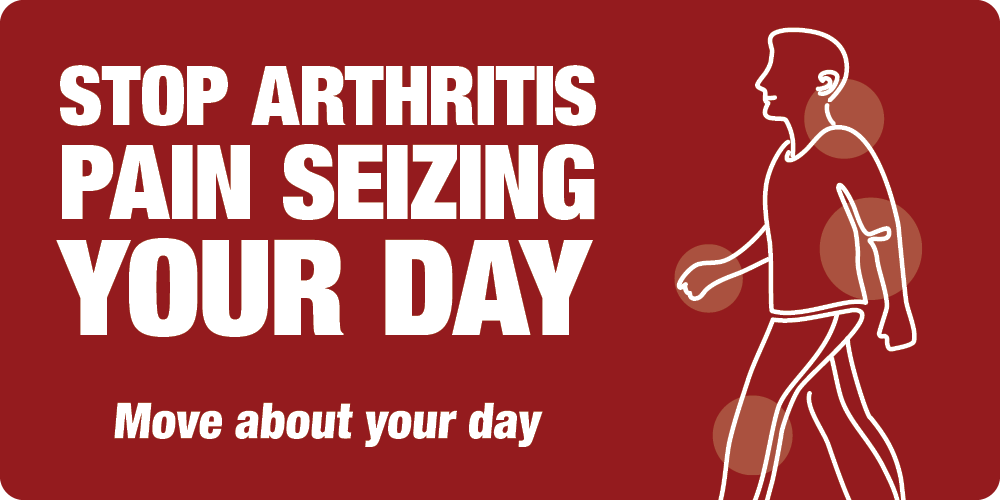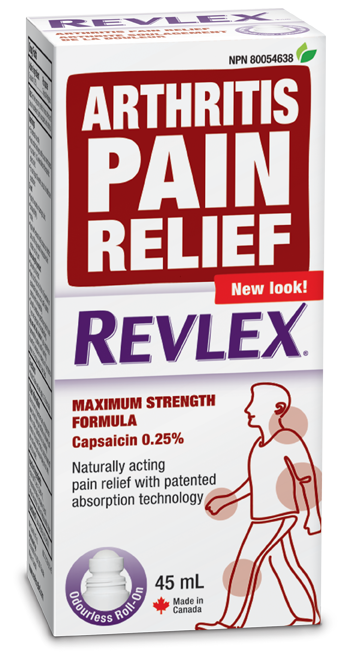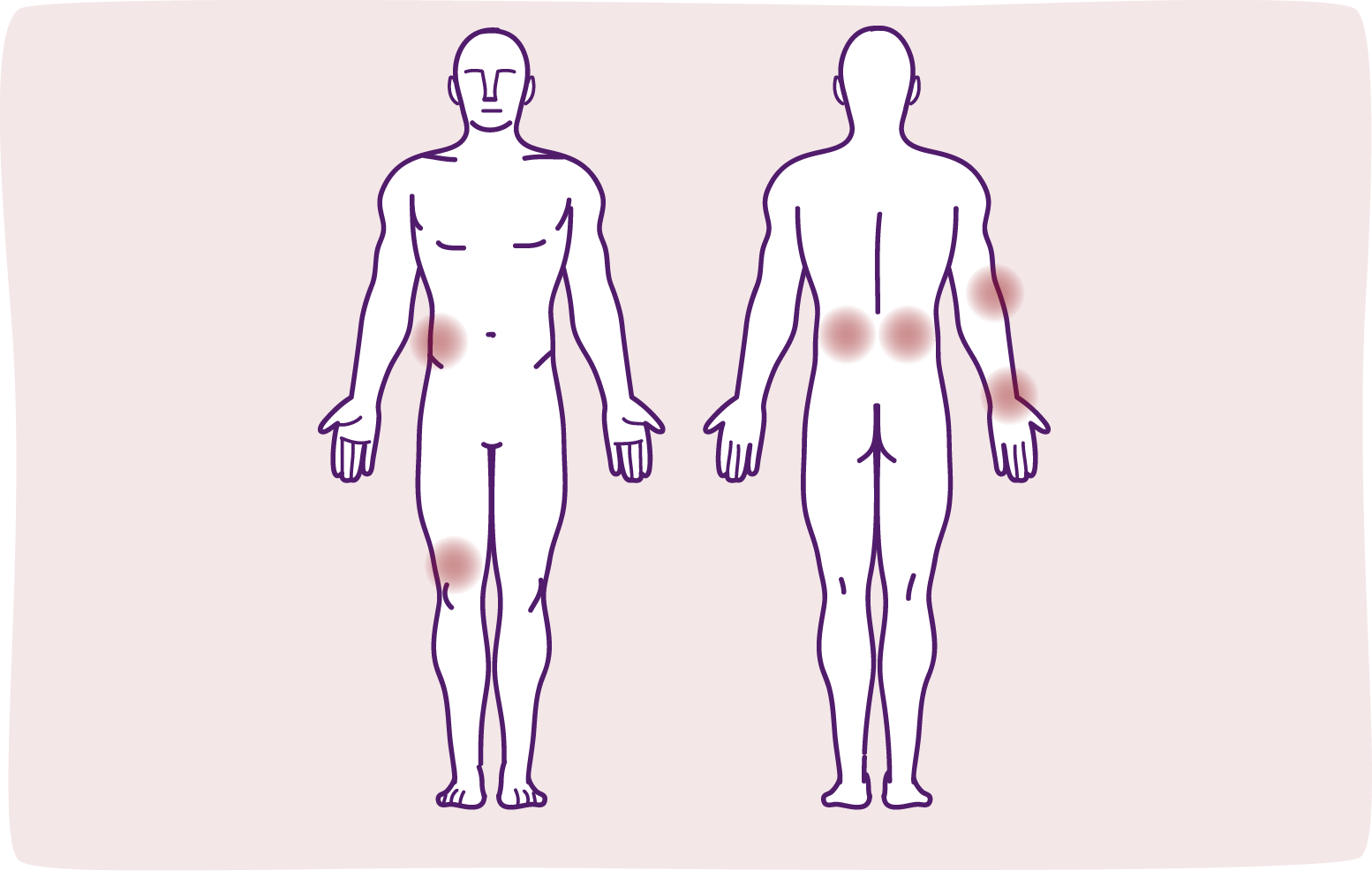

REVLEX®
Arthritis Pain Relief
Arthritis Pain Relief
Stop arthritis pain seizing your day
REVLEX® Arthritis Pain Relief’s patented absorption technology helps you move past your pain. A naturally acting odourless roll on, REVLEX® Arthritis Pain Relief is formulated to minimize burning and irritation. Available in a non-greasy and easy to apply roll-on, our patented formula is clinically proven to provide quick relief of arthritis aches and pains – and get you moving about your day.
Get moving with rapid pain relief
High strength capsaicin has been shown to provide rapid pain relief (48% reduction in pain levels) after only 2 days of regular use (vs. 2-4 weeks in regular strength capsaicin products)*


Bundles
Shop bundled products and save.Buy More and Save
Buy 2 get FREE SHIPPING
Buy 3 get 15% off plus FREE SHIPPING
How It Works
Capsaicin is key to moving about your day
REVLEX® Arthritis Pain Relief’s patented absorption technology contains 0.25% capsaicin; that’s the active component in chili peppers. Formulated to minimize burning and irritation, Capsaicin provides relief of arthritis pain by blocking the pain signals between your joints and brain. It’s the naturally acting roll-on that helps you move past your pain.
REVLEX® uses ‘bubbles of relief’ to get under the skin
Irritation is a common issue for topical capsaicin ointments. To reduce the chance that capsaicin will irritate the surface of your skin, REVLEX® Arthritis Pain Relief encapsulates capsaicin inside a unique carrier technology that REVLEX® calls ‘bubbles of relief’. These encapsulated capsaicin bubbles help avoid skin irritation by penetrating the skin, where it can be most effective at relieving your arthritis pain, deep beneath the skin.
Move about – day in, day out
Because REVLEX® delivers the capsaicin deep beneath the skin to avoid surface irritation, therapy withdrawal is much less likely. Through a reduction of the irritation effect, REVLEX® is able to significantly reduce the pain associated with arthritis as well as, improve the drug’s efficacy and enhance patient compliance. Enjoy relief and the ability to move about your day, every day.
Indications
REVLEX® Arthritis Pain Relief is formulated to relieve arthritis, a condition that effects joints such as wrists, elbows, and knees.
Common symptoms include joint pain, morning stiffness, loss of flexibility, and a grating sensation.
Side effects/ Contraindications/ Drug interactions
- As capsaicin works to relieve your pain, it may generate heat and/or a burning sensation, especially in the beginning. These sensations will subside with continuous use. If the sensations become bothersome, wash the area using cold water and soap. Apply ice on area briefly if needed.
- REVLEX® Arthritis Pain Relief doesn’t have any contraindications and will not interact with any medication you may be taking.
Active Ingredients
Capsaicin 0.25% (Topical Analgesic)
Inactive Ingredients
Alcohol, Aqua/water/Eau, BHT, Magnesium Chloride, Oleth-2, Oleth-10, Phosphatidylcholine, Propylene Glycol, Sodium Metabisulfite, Sodium Ascorbate.
Directions for use
- Apply a thin layer over the arthritic joint 1-2 times daily. Don’t rub.
- This product is recommended for use on: wrists, elbows and knees.
- Apply on the hip and lower back with caution.
- Application on the shoulder or neck may lead to discomfort and is NOT recommended.
- It is recommended to store the bottle in the fridge once it has been opened.
Application Zones
For best results, apply REVLEX® to the suggested application zone that corresponds to your arthritis pain.

When applying REVLEX®, do not apply to wounds and damaged skin or bring into contact with eyes, mouth, nostrils or genitals. Do not bandage tightly; apply with external heat such as an electric pad or apply immediately before or after activities such as bathing, swimming, sunbathing, and strenuous exercise. Avoid inhaling vapors from solution or dried residue; this can result in temporary coughing, sneezing, tearing, throat or respiratory irritation.
Treatment Comparatives
REVLEX® Arthritis Pain Relief is formulated to get you moving
REVLEX® is formulated to move fast so you can move about your day sooner. Because it’s a topical roll-on, REVLEX® is easily applied directly to the source of your arthritis pain for quick targeting of your painful joints.
When compared to leading Arthritis Pain Relief ointments and pills, REVLEX® takes first in first-line treatment. There are several topical analgesics and pills to choose from but they don’t all provide the same arthritis relief and convenience of REVLEX®.
Look and compare. Only REVLEX® provides quick, clean and risk free roll-on relief right at the source of your arthritis pain.
Compare REVLEX® Arthritis Pain Relief to other topical pain relievers
REVLEX® |
Other Topical Ointments |
|
|---|---|---|
| Odourless non-messy, easy to use roll-on |  |
|
| Non-sticky |  |
Some ointments |
| Does not cause significant skin irritations |  |
|
| Provides quick relief |  |
Some ointments |
Compare REVLEX® Arthritis Pain Relief to pills
REVLEX® |
Pills |
|
|---|---|---|
| Medicine applied directly at source of pain |  |
|
| Has an active ingredient for pain |  |
 |
| Has no side-effects on stomach, kidneys or liver |  |
|
| Has no contraindications or drug interactions |  |
Some pills |
FAQs
Find it in-store here.
Testimonials
How REVLEX® helps people move about their day
“…Having tried a number of creams that didn’t work I was somewhat skeptical that this would be the one that would give me some relief. I was totally amazed! It works! I can go for longer walks and exercise more during my AquaFit classes. A big thank you. Once again I have quality of life!”
Brampton, ON
L. Huncar
“REVLEX ®Roll-on-Lotion was extremely helpful when applied as a pain reliever. I used the medication/twice a day (morning & night) and found it more beneficial in controlling my lower back pain upper leg pain in the morning than at night.”
M. Trasewich
REVLEX® Arthritis Pain Relief Bundles
REVLEX® Arthritis Pain Relief and REVLEX® Muscle Pain Relief Bundles
REVLEX® Arthritis Pain Relief and REVLEX® Sleep Time Bundles

